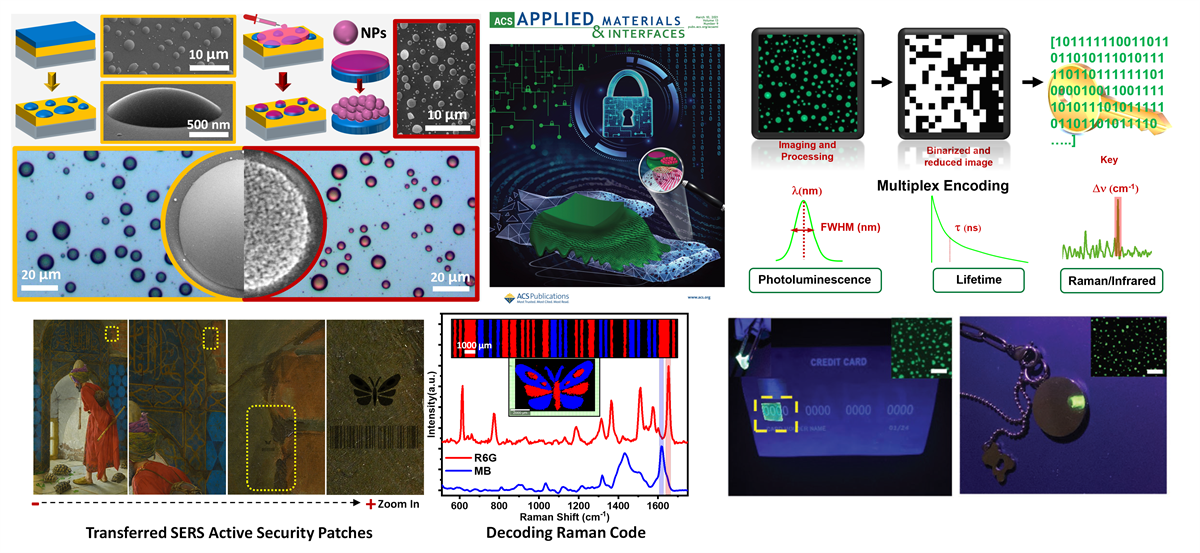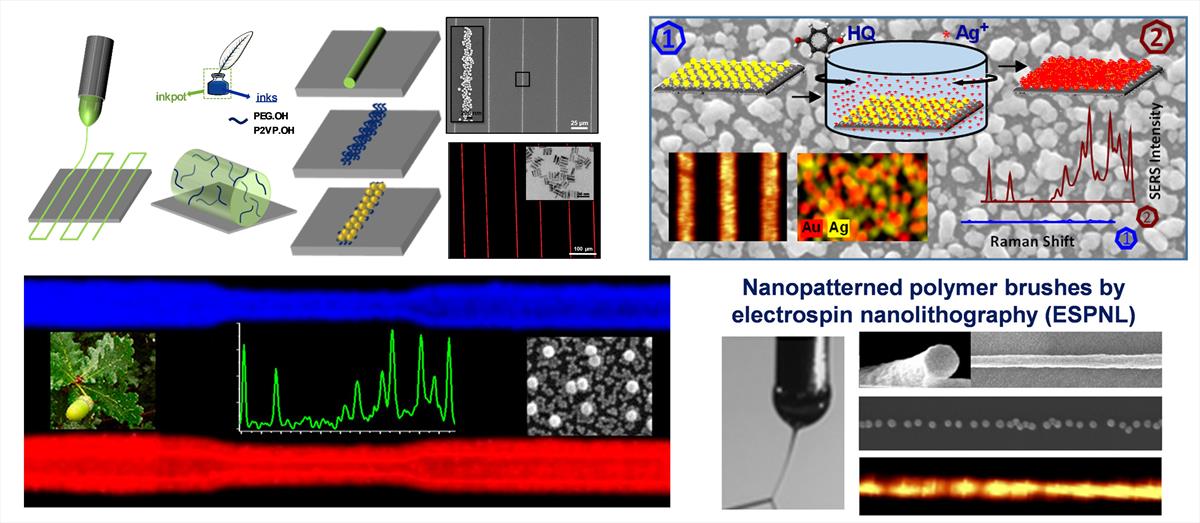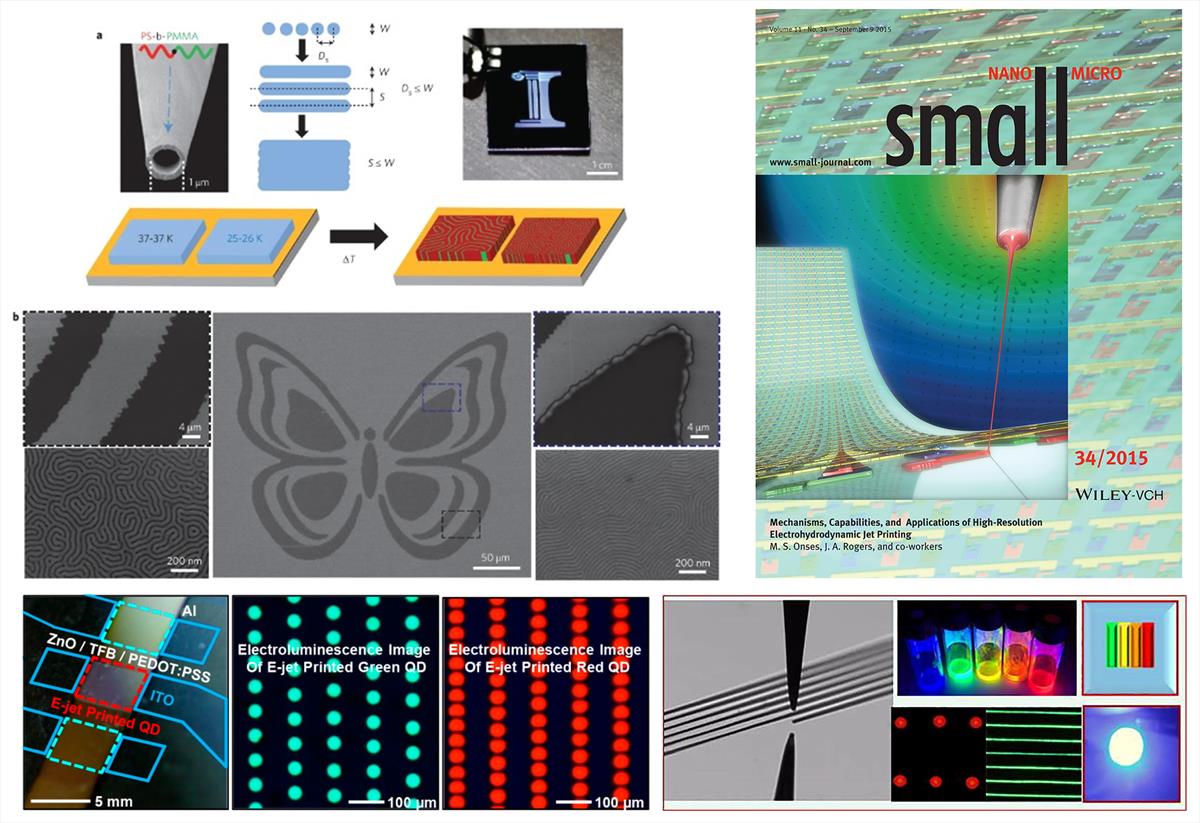The main theme of our research program is understanding and designing processes of self-assembly for generation of surfaces structured at nanometer and micrometer length scales. Understanding the pathways for self-assembly of structured surfaces is critically important to develop technology platforms for society, as the resulting nanostructured surfaces have a broad range of applications. Our current research focuses on fabrication of encoded surfaces and multifunctional superhydrophobic coatings.
The following presents a brief summary of research directions in our group.
Encoded Surfaces

The design and development of novel encoded surfaces are of great research interest in today’s world for use in anti-counterfeiting, authentication, and data storage applications. Broadly speaking, encoded surfaces can be prepared by using deterministic and stochastic pathways. In the former approach, discrete geometries are patterned on the surface of objects for encoding. One-dimensional and two-dimensional barcodes are widely utilized examples to this approach. Advanced materials with unique optical, magnetic and electronic properties together with patterning strategies offer opportunities for fabricating encoded surfaces.
In a complementary approach, stochastic processes can be used for encoding. Physically unclonable functions (PUFs), in particular, are receiving growing interest. PUFs rely on physical systems rather than digitized keys and are defined based on challenge-response pairs. A physical system rather than a mathematical function is used to generate a response to a challenge. The physical system generates a unique and unclonable response to a challenge. The uniqueness and unclonability emerge from the stochastic physical process used to construct PUFs.
In our research program we are interested in both stochastic and deterministic encoding approaches. Taking advantage of dewetting and electrohydrodynamic instabilities together with using different forms of nanoparticles, organic semiconductors, and polymers, we are developing multi-functional PUFs. We explore the use of advanced fabrication approaches (e.g. lithography and electrohydrodynamic jet printing) to fabricate hybrid encoded surfaces based on deterministic and stochastic pathways.
Representative publications:
- Torun, N.; Torun, I.; Sakir, M.; Kalay, M.; Onses, M. S.* "Physically Unclonable Surfaces via Dewetting of Polymer Thin Films" ACS Applied Materials & Interfaces 2021. Featured in the cover. Click Here
- Kayaci, N.; Ozdemir, R.; Kalay, M.; Kiremitler, N. B.; Usta, H.*; Onses, M. S.* "Organic Light-Emitting Physically Unclonable Functions" Advanced Functional Materials 2021. Click Here
- Sahin, F.; Pekdemir, S.; Sakir, M.; Gozutok, Z. Onses, M. S.* "Transferrable SERS Barcodes" Advanced Materials Interfaces 2022. Featured in the inside front cover. Click Here
- Esidir, A.; Kiremitler, N. B.; Kalay, M.; Basturk, A.; Onses, M. S.* "Unclonable Features via Electrospraying of Bulk Polymers" ACS Applied Polymer Materials 2022. Click Here
- Pekdemir, S.; Ipekci, H. H.; Serhatlioglu, M.; Elbuken, C.; Onses, MS. "SERS-active linear barcodes by microfluidic-assisted patterning" Journal of Colloid and Interface Science 2021. Featured in the cover. Click Here
Multi-functional superhydrophobic coatings
Superhydrophobic coatings have attracted considerable attention in the fields of materials and interface science with strong promise for a broad range of applications covering almost all aspects of our daily lives. These coatings enable self-cleaning, anti-icing, anti-corrosion, anti-fouling properties to surfaces and show strong promise for aviation, automobile, textile, ceramic, energy and environmental industries.
Our group is working on multi-functional and mechanically durable superhydrophobic coatings. We are particularly interested in developing structural engineering approaches to increase the mechanical durability, fluorine-free fabrication of superhydrophobic coatings using eco-friendly materials and novel routes to incorporate additional properties (e.g. anti-reflectivity) to such coatings.
Representative publications:
- Celik, n., Torun, I., Ruzi, M., Esidir, A., Onses, M. S., "Fabrication of Robust Superhydrophobic Surfaces by One-step Spray Coating: Evaporation Driven Self-assembly of Wax and Nanoparticles into Hierarchical Structures" Chemical Engineering Journal (2020) Click Here.
- Torun, I., Celik, N., Hancer, M., Es, F., Emir, C., Turan, R., Onses, M. S.* “Water Impact Resistant and Antireflective Superhydrophobic Surfaces Fabricated by Spray Coating of Nanoparticles: Interface Engineering via End-Grafted Polymers” Macromolecules 2018, 51, 10011-10020. Click Here
- Sahin, F., Celik, N., Ceylan, A., Pekdemir, S., Ruzi, M., Onses, M. S.* "Antifouling superhydrophobic surfaces with bactericidal and SERS activity" Chemical Engineering Journal (2022) Click Here.
- Torun, I. Onses, M. S.* “Robust superhydrophobicity on paper: Protection of spray-coated nanoparticles against mechanical wear by the microstructure of paper” Surface and Coatings Technology 2017, 319, 301-308. Click Here
- Torun, I., Ruzi, M., Er, F., Onses, M. S.* “Superhydrophobic coatings made from biocompatible polydimethylsiloxane and natural wax” Progress in Organic Coatings 2019, 136, 105279. Click Here
Plasmonically active nanostructured surfaces for sensing and authentication applications

Metallic nanostructures exhibit interesting optical properties as a result of their localized surface plasmon resonances, which are light induced oscillation of free electrons. Their optical properties depend on the size, shape, structure and composition of the individual nanoparticles. More interestingly, the collective properties of metallic nanoparticle assemblies are determined by the spatial arrangement of the individual particles.
In our group, we are particularly interested in the assembly of colloidal metallic nanoparticles to fabricate plasmonically active solid substrates. We use different nanofabrication approaches together with polymer thin films and wet-chemical approaches to fabricate plasmonic assemblies of nanostructures. Currently we are exploring the application of these nanostructures in molecular sensing through Surface-enhanced Raman spectroscopy (SERS) and development of plasmonic security labels.
Representative publications:
- Kiremitler, N. B., Torun, I., Altintas, Y., Patarroyo, J., Demir, H. V., Puntes, V., Mutlugun, E., Onses, M. S.* “Writing chemical patterns using electrospun fibers as nanoscale inkpots for directed assembly of colloidal nanocrystals” RSC Nanoscale 2020, Click Here
- Karabel Ocal, S., Pekdemir, S., Serhatlioglu, M., Ipekci, H. H., Sahmetlioglu, E., Narin, I., Duman, F., Elbuken, C., Demirel, G., Onses, M. S.* “Eco-friendly fabrication of plasmonically active substrates based on end-grafted poly (ethylene glycol) layers” ACS Sustainable Chemistry & Engineering 2019, 7, 4315-4324.Click Here
- Ocal Karabel, S., Patarroyo, J., Kiremitler, N. B., Pekdemir, S., Puntes, V. F., Onses, M. S.* “Plasmonic assemblies of gold nanorods on nanoscale patterns of poly (ethylene glycol): Application in surface-enhanced Raman spectroscopy” Journal of Colloid and Interface Science 2018, 532, 449-455.Click Here
- Sakir, M., Pekdemir, S., Karatay, A., Küçüköz, B., Ipekci, H. H., Elmal, A., Demirel, G., Onses, M. S.* “Fabrication of Plasmonically Active Substrates using Engineered Silver Nanostructures for SERS Applications” ACS Applied Materials & Interfaces 2017, 9, 39795-39803.Click Here
- Kiremitler, N. B., Pekdemir, S., Patarroyo, J., Karabel, S., Torun, I., Puntes, V. F., Onses, M. S.* “Assembly of Plasmonic Nanoparticles on Nanopatterns of Polymer Brushes Fabricated by Electrospin Nanolithography” ACS Macro Letters 2017, 6, 603-608.Click Here
Printing driven assembly of materials for device applications

A set of technologically important applications, such as, flexible electronics light emitting diodes, displays, sensors and biomedical devices, require direct patterning of diverse set of materials in 2-D and 3-D architectures onto non-planar and flexible substrates. Jet printing approaches that rely on the localized delivery of materials of interest directly to substrates offer a solution to these challenges.
We use conventional ink-jet and electrohydrodynamic jet (e-jet) printing systems for patterning materials at length scales from centimeters to nanometers. Our current focus is development of self-assembling ink materials and processing routes for applications in wearable electronics, supercapacitors, and optoelectronics.
Representative publications :
- Onses, M. S., Song, C., Williamson, L., Sutanto, E., Ferreira, P. M., Alleyne, A. G., Nealey, P. F., Ahn, H., Rogers, J. A. “Hierarchical Patterns of Three Dimensional Block-Copolymer Films Formed by Electrohydrodynamic Jet Printing and Self-Assembly”Nature Nanotechnology 2013, 8, 667-675. Click Here
- This paper was highlighted by Prof. Richard Register with News & Views article “Nanolithography: Painting with Block Copolymers”Nature Nanotechnology 2013, 8, 618-619.
- This paper was highlighted in the October issue of Nature Materials “Changing domains”Nature Materials 2013, 12, 870.
- Onses, M. S.*, Sutanto, E., Ferreira, P. M., Alleyne, A. G., Rogers, J. A. “Mechanisms, capabilities and applications of high resolution electrohydrodynamic jet printing” Small 2015, 11, 4237-4266. Click Here
- This paper was featured in the Cover of Small
- Kim, B. H., Onses, M. S., Lim, J. B., Nam, S., Oh, N., Yu, K. J., Lee, J. W., Kim, J. H., Kang, S. K., Lee, C. H., Lee, J, Shin, J. H., Kim, N. H., Leal, C., Shim, M., Rogers, J. A. “High-Resolution Patterns of Quantum Dots Formed by Electrohydrodynamic Jet Printing for Light-Emitting Diodes” Nano Letters 2015, 15, 969-973. Click Here
- Altintas, Y., Torun, I., Yazici, A. F., Beskazak, E., Erdem, T., Onses, M. S.*, Mutlugun, E. “Multiplexed patterning of cesium lead halide perovskite nanocrystals by additive jet printing for efficient white light generation” Chemical Engineering Journal 2020, 380, 122493. Click Here
- Gozutok, Z., Kinj, O., Torun, I., Ozdemir, A. T., Onses, M. S.* “One-step deposition of hydrophobic coatings on paper for printed-electronics applications” Cellulose 2019, 26, 3503-3512. Click Here